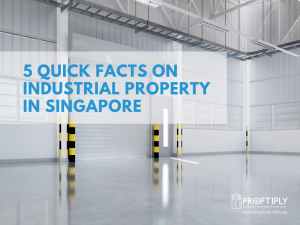
Are you looking to build on or diversify your investment property portfolio? Property investors can consider industrial properties as an alternative to residential properties. Here’s a brief introduction to industrial property in Singapore.
1. Types of industrial property
According to the URA, industrial developments comprise factories, warehouses, telecommunication and utility buildings. Industrial property can divided into several categories including Business 1 (B1), Business 2 (B2), Business Parks and Science Parks.
B1 industrial properties are used for businesses engaged in clean or light activities. Examples of B1 industrial trades include software development, printing or publishing, media production, food packing, call centre support and light manufacturing. Generally, the noise output from B1 activities is minimal. Therefore, B1 industrial properties are for activities which do not impose a nuisance buffer greater than 50m.
B2 industrial properties are for general and special industries involved in heavier manufacturing and production, assembly, repair and servicing, amongst others. These heavier production activities usually have a greater environmental impact – for example, they could cause noise or air pollution. Therefore, a 100m nuisance buffer is imposed from B2 zones to the surrounding area. This is also the reason that B2 industrial zones are usually located a further away from residential areas.
Business and science parks comprise clusters of office spaces, headquarter buildings and R&D facilities in designated zones. These businesses are usually involved in R&D, high technology or knowledge-intensive activities. Pollutive activities are not allowed in business and science parks.
2. The 60:40 allowable use ratio
The 60:40 rule requires that at least 60% of the gross space or total floor area of the industrial property must be used for industrial activity. The other 40% of the gross space can be used for ancillary (or supporting) purposes.
Examples of ancillary purposes include setting aside the space for ancillary offices, showrooms, meeting rooms, industrial canteens, display areas, childcare centres and meeting rooms.
3. Tenure
Industrial properties in Singapore are usually leasehold. 60-year leases are common, but 30-year leases are gaining in popularity.
The number of years remaining on the lease of the industrial property is important as it will affect the maximum loan tenure allowed for the purchase of the property. While shorter lease tenures could mean greater affordability, it could also affect the selling price and subsequently your investment gains.
4. Additional buyer stamp duty and seller’s duty
Unlike residential properties, the Additional Buyer’s Stamp Duty (ABSD) is not applicable to industrial properties.
However, the Seller’s Stamp Duty (SSD) applies to industrial properties bought on or after 12 Jan 2013. The applicable SSD rates vary depending on the holding period. The amount of SSD payable is calculated by applying the relevant rate on the actual price or market value, whichever is higher, as at the date of sale.
An SSD rate of 15% applies for industrial properties sold within a year, 10% on properties sold within the second year, and 5% for properties within the third year. SSD does not apply if the holding period exceeds 3 years.
5. Goods and Services Tax
For industrial properties in Singapore, the Goods and Services Tax (GST) rate of 7% is applicable for sales and rental transactions if the seller or landlord of the unit is a GST-registered entity.
However, the GST paid is claimable if the buyer or tenant is also a GST-registered entity. This is provided that the purchase or tenancy agreement is under the GST-registered company’s name.